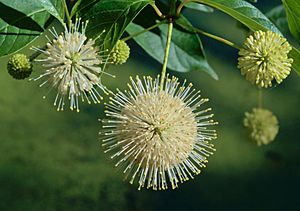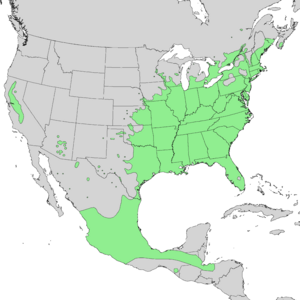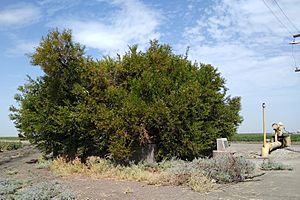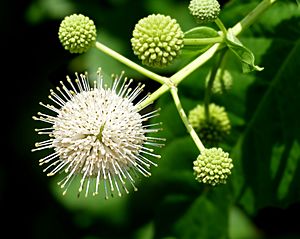Buttonbush facts for kids
Quick facts for kids Buttonbush |
|
|---|---|
 |
|
| Cephalanthus occidentalis var. occidentalis blooming in Point Pelee National Park (Ontario, Canada). | |
| Conservation status | |
| Scientific classification | |
| Genus: |
Cephalanthus
|
| Species: |
occidentalis
|
| Varieties | |
|
C. o. var. californicus |
|
 |
|
| Natural range of Cephalanthus occidentalis | |
Cephalanthus occidentalis, also known as buttonbush, is a cool flowering plant found in eastern and southern North America. People call it by many names like common buttonbush, button-willow, buck brush, and honey-bells. It belongs to the Rubiaceae family, which also includes coffee plants!
Contents
What Does Buttonbush Look Like?
Buttonbush is usually a deciduous shrub or a small tree. This means it loses its leaves in the fall. It typically grows about 1 to 3 meters (3 to 10 feet) tall. Sometimes, it can even reach up to 6 meters (20 feet)!
Its leaves grow in pairs or in groups of three. They are shaped like an oval, about 7 to 18 centimeters (3 to 7 inches) long. The edges of the leaves are smooth.
The most unique part is its flowers. They grow in a tight, round ball, about 2 to 3.5 centimeters (1 to 1.5 inches) across. Each tiny flower is white to pale yellow. They have a long, thin tube shape. After the flowers, the plant produces round clusters of small, nut-like fruit.
Types of Buttonbush: Varieties
Scientists have identified two main types, or varieties, of buttonbush. Not all experts agree they are completely separate, but here they are:
- Cephalanthus occidentalis var. occidentalis: This is the common buttonbush. You can find it across eastern North America. Its range goes from Nova Scotia in Canada all the way to Minnesota and down to Florida and eastern Texas.
- Cephalanthus occidentalis var. californicus: This type is called California button-willow. It grows in southwestern North America. This includes areas from western Texas to California and south into Mexico and Central America.
Where Does Buttonbush Grow?
Buttonbush loves wet places! It's a very common shrub in many wetland habitats. You can find it in swamps, areas that flood often (floodplains), and along rivers (riparian zones). It also grows in moist forest areas and even in mangroves. It's a well-known plant in the Everglades in Florida.
How Buttonbush Helps Nature
Buttonbush is super important for many animals and insects.
- Waterfowl (like ducks) and other birds love to eat its seeds.
- Wood ducks use the plant for safe places to build their nests.
- Mallard ducks enjoy eating the fruit.
- Deer eat the leaves, but the plant can be harmful to farm animals like cows.
- Many insects and hummingbirds visit the flowers for their sweet nectar.
- Bees use the nectar to make honey.
- It's also a special plant for certain caterpillars. These include the hydrangea sphinx, the royal walnut moth, and the titan sphinx. They eat its leaves as they grow.
Where Can You Find Buttonbush?
This plant mostly grows in eastern North America. But you can also find some groups of them far away in the west. In Canada, it grows in southern Ontario and Quebec, and east to New Brunswick and Nova Scotia.
In the United States, it's common in the eastern states and parts of the Midwest. You can also find it in Arizona, the Mogollon Rim, and other mountain areas. In California, it grows throughout the San Joaquin Valley. Outside of the Great Plains and Rocky Mountains, buttonbush is mainly found in western Texas, Arizona, and California.
Uses of Buttonbush
Medicinal Uses of Buttonbush
Historically, people used buttonbush for various medicinal purposes. However, it contains a chemical called cephalanthin. This chemical can be toxic or harmful if eaten. So, it's not safe to use without expert knowledge.
Growing Buttonbush in Gardens
Buttonbush is often grown as an ornamental plant in gardens. People like it for its unique look and because its flowers are a great source of nectar for bees and butterflies. It's also planted on hillsides to help stop erosion (when soil washes away). It's a perfect shrub for gardens designed to attract butterflies.
The Famous Buttonwillow Tree

The town of Buttonwillow, California got its name from a single buttonbush tree. This special tree was a landmark on an old trail that crossed the San Joaquin Valley. Long ago, the Yokuts used it as a meeting place. Later, settlers used the spot for their cattle rodeos. This historic buttonbush tree is now a California Historical Landmark (No. 492). It is still known as the "Buttonwillow Tree."
See also
 In Spanish: Cephalanthus occidentalis para niños
In Spanish: Cephalanthus occidentalis para niños



